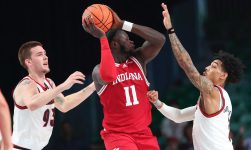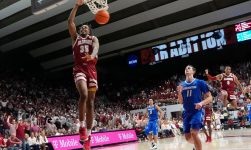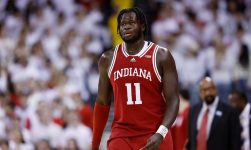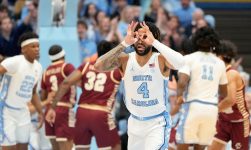MINNEAPOLIS — The unofficial tip off of college basketball season, Big Ten media days, has arrived. Here are five pressing questions facing Michigan basketball before the 2023-24 begins with an exhibition against Northwood on Nov. 7 in Ann Arbor:
Can Michigan replace scoring and shooting production?
Michigan lost a ton of offensive production, highlighted by its top three scorers and top four 3-point shooters.
Longtime center Hunter Dickinson, who averaged 18.5 points per game last season, transferred to Kansas. Last season he became just the second player in program history to lead the team in scoring and rebounding in three consecutive seasons. Jett Howard (14.2 points) and Kobe Bufkin (14.0 points), were NBA lottery picks for the Orlando Magic and Atlanta Hawks, respectively. Joey Baker, who averaged 5.7 points and was second on the team in 3-point shooting (39.1%), elected not to return.
All in all, the Wolverines lost 71.7% of their scoring from a season ago and 76.7% of the scoring from behind the long line.
How will the transfers fit in?
How the Wolverines are able to blend in their three new veterans — Olivier Nkamhoua (Tennessee), Nimari Burnett (Alabama) and Tray Jackson (Seton Hall) — will be key to team success.
RELATED: Why Michigan basketball’s Olivier Nkamhoua believes he’s the missing piece — again
Nkamhoua, a 6-foot-9, 235-pound forward, appears to be the most critical addition. He has played in 112 college games with 58 starts the past four seasons for the Volunteers.
He’s also the only player on U-M’s roster who has averaged in double figures in scoring at a Power Five school. Last season, Nkamhoua averaged a career-high 10.8 points and 5.0 rebounds as he shot 51.3% from the floor, 33.3% on 3-pointers and 69.6% from the free-throw line. He is expected to start at power forward, a welcomed sign after Michigan’s search for reliable minutes at the position a season ago.
Burnett, a former McDonalds All-American, is hoping the third time is the charm after stints at Texas Tech and Alabama. A top-50 recruit in high school, Burnett played in 12 games in Lubbock, Texas, in 2020-21, then transferred to Alabama, underwent knee surgery and took a medical redshirt.
MORE WHERE THAT CAME FROM: Michigan football, at full strength finally, looked like a behemoth
Last season he played in 27 games with nine starts, but Burnett’s season was derailed when he missed nine games with a fractured wrist. Burnett, the likely starting small forward, averaged 5.6 points and will need to improve his shooting efficiency: he shot 36.8% from the floor and just 32.1% on 3-pointers.
Jackson, a Detroit native, should provide depth in the frontcourt. He averaged 6.8 points and 3.5 rebounds as a junior at Seton Hall, then a coaching change resulted in a reduced role as he averaged 6.5 points and 2.2 rebounds in just less than 15 minutes per game last season.
The hope for Jackson is to bring some scoring off the bench as 38.9% shooter from long range the past two years.
Ready for sophomore step?
SOPHOMORE STEP: Tarris Reed Jr. welcomes challenge as Michigan basketball’s next big big man
The two likely candidates to make a Bufkin-like jump this season are freshmen roommates Dug McDaniel and Tarris Reed.
McDaniel was thrown into the point guard fire just nine games into his true freshman season when Jaelin Llewellyn was lost with a season-ending knee injury in December. He fared quite well, averaging just shy of 10 points per game once he was moved into the starting lineup and scored better than 15 points in five of his final eight games.
More importantly, he had better than a 2-to-1 assist-to-turnover ratio. McDaniel is the team’s leading returning 3-point shooter (35.5%) on just fewer than three attempts per game.
REPORT CARD VS. MINNESOTA: Another impeccable performance from Wolverines
Reed was an energy boost off the bench when he would fill in for Dickinson at center. He averaged just 3.4 points and 3.9 rebounds in just more than 12 minutes per game, but where his greatest impact will be made as an offensive rebounder and defender. Reed is one of the Big Ten’s most versatile defenders — athletic enough to hang with guards even when he gets switched in the pick and role while plenty big and physical enough to overpower most big bodies — and shows signs of developing into an elite rebounder.
There’s work to be done on his offensive game where he shot 51.7% from the floor and a concerning 40% from the free-throw line, but Reed told the Free Press this summer people outside the program will notice the step he takes.
Bounce back seasons incoming?
Llewellyn was only expected to be in Ann Arbor for one season, but injury changed that. Now, he returns as an experienced guard looking to write a better ending to his collegiate story.
Llewellyn, who transferred from Princeton a season ago, struggled in his first eight games with Michigan. He averaged 7.0 points, 3.3 rebounds and 2.8 assists as he shot just 30.9% from the floor and just 18.5% on 3-pointers and the question became if it was just a slow start of if the jump in competition was too much?
He isn’t the only U-M player eager for a clean slate. Terrance Williams II was named a captain last season and inserted into the starting lineup as a power forward, but it never quite worked out.
Though he averaged career-highs with 6.1 points and 5.9 rebounds, it was largely a product of playing a career-high 26.6 minutes, as his shooting from the floor dropped to a career-low 38.5% and 3-point shooting fell to just 25%. The hope for Williams, is with more depth in the front court, he can go back to his role as energy off the bench, where he was important at times as a sophomore.
Juwan Howard crossroads?
Howard of course now is focused on his health after an offseason scare that saw him undergo heart surgery on Sept. 15 at University of Michigan hospital.
His expected timetable for a recovery was six to 12 weeks, so he did not travel with the team to Minneapolis —associate head coach Phil Martelli is serving as interim, but it is assistant coach Saddi Washington who traveled with the team for media days.
Beyond that, Howard appears to be at a bit of a crossroads in his tenure in Ann Arbor as the program has seemed to be in steady decline since his arrival. U-M won the Big Ten in Howard’s second full season (his first was cut short because of the pandemic) and advanced to the Elite Eight as Howard was named AP Coach of the Year, but since then things have gone the other direction.
U-M returned to the NCAA tournament in 2021-22, advancing to the program’s fifth consecutive Sweet 16.
But the Wolverines struggled last season (18-16, 10-10 Big Ten) and went to the NIT and got bounced in the second round.
Michigan’s recruiting has taken a dip in recent years — this year’s class has just one freshman, George Washington III — while Howard has seemingly landed two players in the transfer portal the past two seasons, Terrance Shannon and Caleb Love, only for admissions issues to arise and see them transfer elsewhere.
It’s a major reason U-M only has 11 scholarship players this season and if things don’t turn around, in recruiting, NIL and most importantly wins, the future of Howard’s time in Ann Arbor will get cloudier.
Contact Tony Garcia at apgarcia@freepress.com. Follow him @realtonygarcia.
Tune into the “Hail Yes!” podcast wherever you listen to podcasts, with episodes twice per week during the Michigan football season. Catch all of our shows and daily voice briefing at freep.com/podcasts.
This article originally appeared on Detroit Free Press: Michigan basketball big questions: Who will they score this season?






